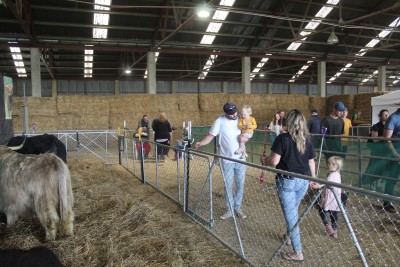NAIT and biosecurity procedures trialed at Wairarapa A&P show
Biosecurity procedures are especially important at events where animals from many different locations are present. Here's how it was handled in Wairarapa.
 At the recent A&P show in Carterton, lifestyler champion Lisa Berthold added a traceability and biosecurity element to the event, to ensure that the beef and dairy cattle were tracked, traced and scrubbed down and separated in stalls ready for show and tell.
At the recent A&P show in Carterton, lifestyler champion Lisa Berthold added a traceability and biosecurity element to the event, to ensure that the beef and dairy cattle were tracked, traced and scrubbed down and separated in stalls ready for show and tell.
Lisa said she had been working on the plan for several months leading up to the show and had received the endorsement of OSPRI from a NAIT and TBfree perspective.
“With the cancellation of A&P shows for the last couple of years due to COVID, the uptake to take part in the A&P show has been quite slow, and M. bovis has also stopped cattle from being shown,” said Lisa.
“A way of encouraging people to return is to put precautionary procedures in place that ensure the animals are not in any danger of spreading disease. This is particularly relevant at the moment given the new strain of M. bovis identified in the Canterbury region and the threat of foot and mouth disease entering the country.”
The first thing the animals had to do when they arrived, was to make sure they were NAIT compliant and appropriately tagged, “If they were not compliant and didn’t have proof of movement to the event’s NAIT account, the animals didn’t get off the truck.”
The next step was to marshal the animals to the wash bay where they were cleaned and then once removed from the wash bay, which was then disinfected. They were taken to their individual stalls via separate entrances. Beef and dairy animals were processed via separate entrances and wash bays. All visitors to the pens were required to walk through foot baths and not able to touch the stock.
OSPRI’s vet and epidemiologist Gillian Atikinson said it's vital that biosecurity measures are in place for shows such as the one held in Carterton, and it was very pleasing to see it implemented so well.
OSPRI’s Head of Traceability Kevin Forward said the NAIT Compliance Requirements exceeded minimum requirements prescribed in the NAIT Act 2012. “I commend and congratulate Lisa on taking such a proactive stance to ensure good traceability practices at the show. There are a lot of lifestyle blocks in the Wairarapa and Wellington region and there’s a genuine interest in that area to understand what the obligations are and how they can improve their farming practices.”

